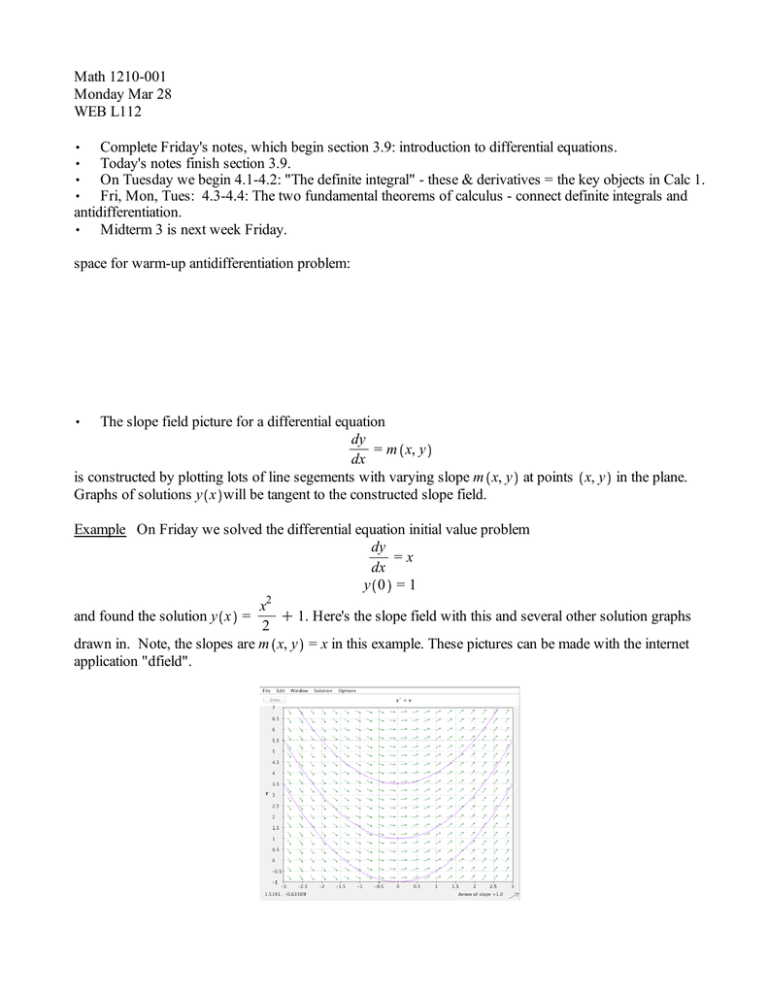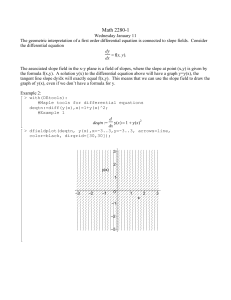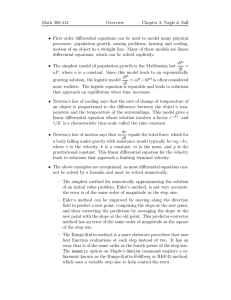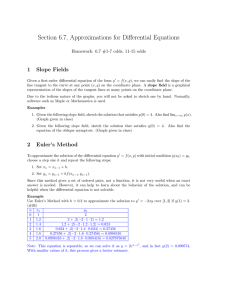Math 1210-001 Monday Mar 28 WEB L112
advertisement

Math 1210-001 Monday Mar 28 WEB L112 , Complete Friday's notes, which begin section 3.9: introduction to differential equations. , Today's notes finish section 3.9. , On Tuesday we begin 4.1-4.2: "The definite integral" - these & derivatives = the key objects in Calc 1. , Fri, Mon, Tues: 4.3-4.4: The two fundamental theorems of calculus - connect definite integrals and antidifferentiation. , Midterm 3 is next week Friday. space for warm-up antidifferentiation problem: The slope field picture for a differential equation dy = m x, y dx is constructed by plotting lots of line segements with varying slope m x, y at points x, y in the plane. Graphs of solutions y x will be tangent to the constructed slope field. , Example On Friday we solved the differential equation initial value problem dy =x dx y 0 =1 2 x and found the solution y x = C 1. Here's the slope field with this and several other solution graphs 2 drawn in. Note, the slopes are m x, y = x in this example. These pictures can be made with the internet application "dfield". Slope field picture for the IVP in Exercise 1 from Friday's notes. 1 f# x = 3 x f 1 =5 Is the picture consistent with the solution we find? Separable Differential Equations So far, all of our differential equations have been ones we can solve via antidifferentiation, dy =f x dx 0 y = f x dx. For many first order DE's the specified slope of the solution y x depends not only on the variable x but also on the value of the function y: dy = m x, y . dx If the slope function m x, y is a product (or quotient) of a function of x times a function of y, then we can't solve directly by integration, but we can still use the chain rule backwards (and a method called "separation of variables") to solve them. If the DE is dy f x = dx g y then the mathematically rigorous way to find the solution is to rewrite the DE as g y y# x = f x . So if G # y = g y , F# x = f x , we can rewrite this as G # y x y# x = F# x and use the chain rule in reverse to antidifferentiate with respect to x: D xG y x = D xF x 0 G y x = F x C C. This yields y implicitly defined as a function of x, from which one may or may not be able to explicitly solve for y x . Differential magic lets us get to the same correct answer more smoothly dy f x = dx g y g y dy = f x dx g y dy = f x dx G y C C1 = F x C C2 G y = F x CC Exercise 1) Solve the differential equation initial value problem dy = x y2 dx y 0 =1 using separation of variables. Compare to the slope field picture below.



